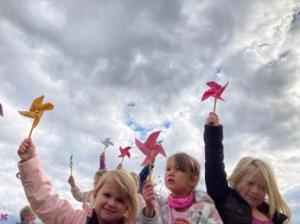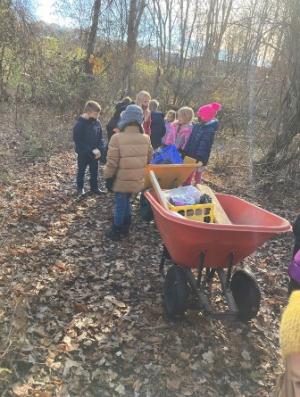November was another great month in outdoor education as we were able to hold on to the fall weather until the very end of the month when we finally welcomed winter to the ACS kingdom. Great fall weather allowed for a number of outdoor activities like investigating weather with pinwheels, running an Oregon trail simulation with wheelbarrows, and freeing trees of invasive vines.
Kindergarten

1st
We spent some time thinking about what life was like for people in America’s early days in first grade OE. Students had a visit from a special guest from the past, Johnny Appleseed (who had a striking resemblance to a barefooted Mr. Sportel). Mr. John Chapman shared a bit about his life story around the campfire. First grade also discussed and practiced some of the chores that kids would have to do if they grew up in the times of pilgrims and pioneers.
2nd

3rd
The third graders completed their final scientific illustrations of their greenhouse plants (beans, cucumbers, or peas) and used their drawings to create a lifecycle showing the different stages of their plant’s life. Our bean plants have nearly reached the ceiling in the greenhouse! Third graders also dissected different fruits like tomatoes, squash, beans, peas, and apples (we learned that botanical fruits are anything with seeds inside!). We also sent on a seed hunt throughout the school property to find seeds that move in all different ways to travel and make new plants.
4th
We took some time in fourth grade to plant our winter garden in the hoop house and take care of some garden chores. Another week students took a tour of school considering what plants grow in which areas and why. This related to the topic of “range of tolerance” they were learning about in science. We followed that up with a discussion on invasive species followed by cutting some of the many oriental bittersweet vines climbing and damaging the trees.
5th
We discussed the life cycle of our goat herd at Ada Christian and learned that with fall comes stinky bucks and tail-wagging does! That’s right, mating season is upon us. We welcomed two bucks this season, Nicholas and Nelson. We have learned (and smelled) by observation how goats find and attract their mates. On a different (cleaner) note, the fifth graders made their own water filters to consider how creating wells provides clean water naturally filtered by the ground as part of their Water Walk project.
6th
[IMAGE '2030' /]Our chicks are nearly grown! Stop by to see our pullets and cockerels in new chicken stall nearest the track (open the shutters to say hi!). They have their adult feathers now and are able to regulate their body temps out in the winter barn. We are partway through job performance meetings for Got Yolk, and we are continually improving and honing our chicken care skills (we’ve gotten our egg washing down to a science!). We have also begun discussion of chicken-keeping finances with Mr. Stepanek in math class and are excited to watch our profits grow over the next 8 weeks.
7th
Our time in seventh grade was spent primarily on learning the tree species we had been studying. Students worked in groups to create presentations that included pictures and information about the trees. They then used these presentations to learn to identify the trees.
8th
We transitioned into the planning phase of the legacy project in eighth grade. The students first spent time reflecting on how they have been shaped by the outdoors by writing a quick poem during sit spot time. They then toured the previous legacy projects and brainstormed what they might like to do for their own project.
